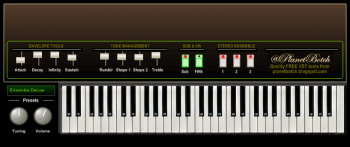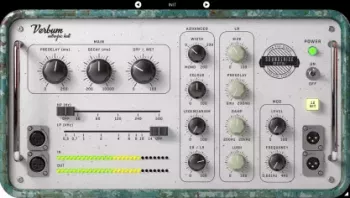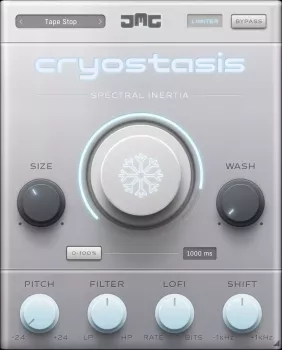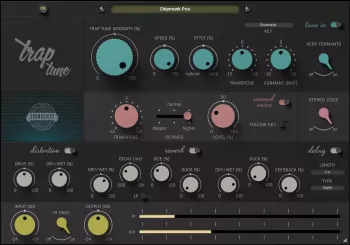22 DECEMBER 2015 | FREE | WIN VST
英文简介:
Planet Botch’s new Ensembletron VSTi serves only one purpose, but it serves that purpose extremely well, in an eminently user-friendly manner. This is a virtual analogue string machine inspired by classic 1970s beasts such as the Solina and Roland string synths. However, the Ensembletron is by no means a copy.
Apart from offering a high quality yet gritty and slightly rough string sound with a great balance of fidelity and warmth, the Ensembletron features a unique three-stage Ensemble section which animates and adds stereo spatial spread to the output. As you might expect, there are adjustments for slow attack, decay and sustain, but there’s also an advanced yet simple-to-use Tone Management system which can significantly change the character of the sound from vintage to modern.
And it’s on simplicity that this VSTi majors. The whole control set can be explained in one blog post. If you want to add analogue-type string pads and melody lines whilst controlling literally everything from the front panel (and do so for free), you’ve come to the right place.
MAIN CONTROLS
To the left of the keyboard, you’ll find the Ensembletron’s Main Controls, comprising a Tuning knob, a Master Volume knob, and a Preset Selector. You can select from 12 presets by clicking on the selector window.
ENVELOPE TOOLS
The Envelope Tools set the note attack and sustain time, as well as allowing you to select between infinite and variable decay.
The Attack slider adjusts between instant attack (with a ‘soft’ string-type impact), and slow attack, in which each note fades in gradually.
The Decay slider (which can be disengaged using the adjacent Infinite slider) determines how quickly each held (as opposed to released) note will die away.
The Infinite slider is really just an on/off switch for the Decay slider. Set to On (up), the Infinite slider disengages the Decay and enables the Ensembletron to produce organ-style infinity in which notes will persist at the same volume for as long as you hold them down. Set to Off (down), Infinite allows the Decay to become active, so each held note will die away - at a rate depending on how the Decay is set.
The Sustain slider adds levels of sustain after each note is released. With this control set at its lowest level, the sustain on release is removed. With the control at its highest you get a long, post-release fade, which works well in some moody and atmospheric contexts.
TONE MANAGEMENT
The Tone Management section governs the personality of the Ensembletron’s basic string sound.
The Rumblr slider adds or subtracts deep, rumbling bass in accordance with your taste.
Shape 1 controls the low midrange area of the basic tone. This is particularly useful in instances where you’ve employed the Sub waveform (more info coming up) and you want to lessen or exaggerate its impact on the sound.
Shape 2 controls the high midrange area of the basic tone. This is particularly useful in conjunction with the Treble slider. With Shape 2 set high and Treble set low, you’ll get a more vintage, lo-fi sound. With Shape 2 reduced and Treble set high, things will sound more modern. Take Shape 2 right down to its lowest level in instances where a mix is busy with punchy instruments and you want your string pad to add warmth without confusing the punch.
The Treble control adjusts the highest frequencies, and works well in conjunction with Shape 2, as previously mentioned.
SUB & 5th
By default, the Ensembletron produces a pure fundamental string note. However, the Sub switch can add a lower, ‘cello-pitch’ register one octave beneath the main fundamental. This expands on the ensemble feel and makes the overall sound more substantial and ‘orchestral’. I’m using the quotes because this instrument simulates an old analogue string synthesizer and not a real string section – but in pitch terms the relationship with real string instruments is still relevant. If you feel the Sub frequency makes your sound too bassy or bottom-heavy, try cutting the Shape 1 level.
The Fifth switch adds another string voice one fifth above the fundamental. If you find this extra component too dominant, try reducing the Shape 2 level - or Shape 1 to a lesser degree.
Tip: The sound from this instrument is potentially very rich, so when you have multiple stages of Ensemble animation engaged, you may find that activating both the Sub and Fifth voices together produces a sound that's too thick to integrate into most mixes.
STEREO ENSEMBLE
The three-stage Stereo Ensemble section is where all the magic happens. It’s a simple set of push buttons, each introducing a different variety of Ensemble animation – all in full stereo. You can employ each variety of Ensemble animation separately, or in combination with the others. You may want to engage Ensemble 3 for a light wavering shimmer on a pure fundamental line, or Ensemble 1 for a richer depth on sub-octave-boosted chord pads. Combine all three Ensemble selections and you get a big, complex animation with analogue personality.
Ensemble 1 adds a very classy symphonic thickening.
Ensemble 2 adds a much more vintage-sounding chorusing effect.
Ensemble 3 adds a special string-focused animation, which is subtle enough for applications where the other Ensemble stages would be too powerful.
OTHER INFO
The Ensembletron can record real-time control changes and replicate them on playback.
The Ensembletron is monotimbral, but you can open as many instances as your computer’s resources will permit.
There’s no inherent facility to load or store presets. Your settings can, however, be saved as part of a VST song or arrangement.
官网: http://planetbotch.blogspot.com/2015/12/the-ensembletron-string-synth-freeware.html







评论0